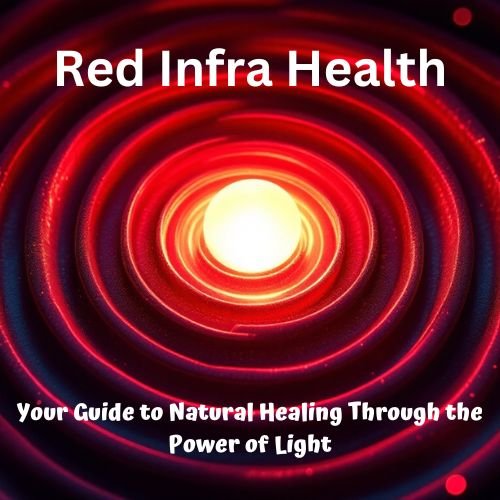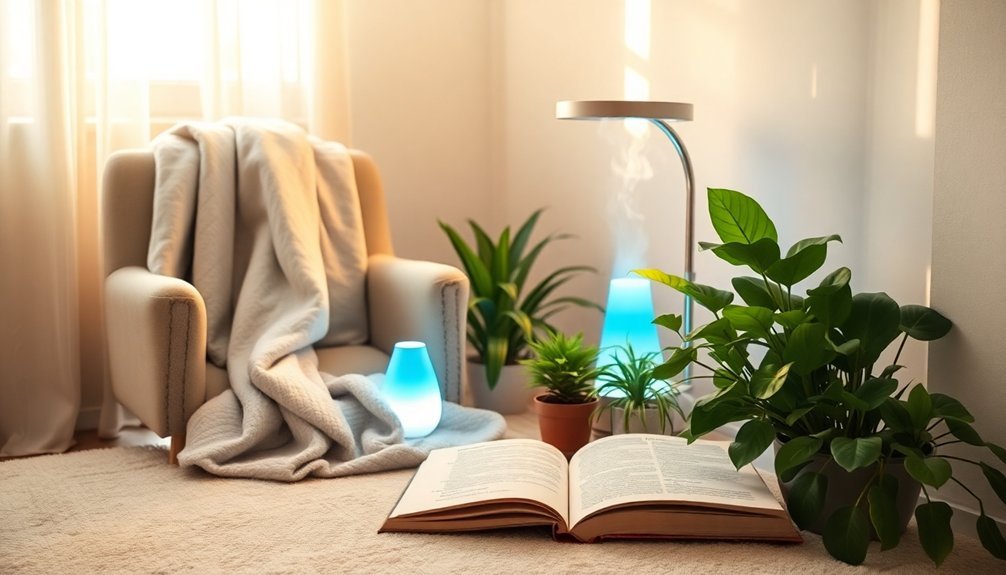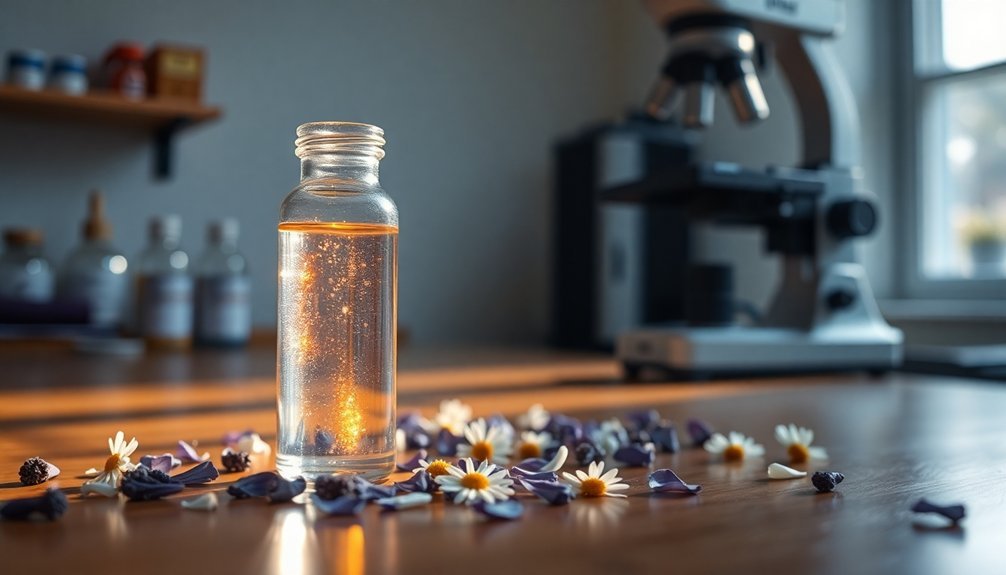LED light therapy effectively targets aging eyes and crow's-feet through several proven treatment options. You'll find professional LED masks that provide full-face coverage, targeted eye-specific devices for precise application, and combination wavelength systems that use both red and near-infrared light. At-home devices like handheld wands let you focus on problem areas, while clinical LED sessions offer professional-grade results. For the best outcomes, you'll want to use these treatments 3-6 times weekly for 4-6 weeks, following proper safety guidelines and cleaning protocols. Discover which of these science-backed solutions will work best for your specific aging concerns.
Professional LED Eye Masks

Professional LED eye masks have emerged as a cutting-edge solution for aging skin around the eyes. These devices use specific wavelengths of light, with red light stimulating collagen and elastin production, while near-infrared light penetrates deeper for rejuvenation. The masks are designed with safety features built-in to protect your eyes during treatment.
If you're considering an LED eye mask, make sure it's FDA-cleared for safety around the delicate eye area.
You'll find various professional-grade options available, like the globally recognized OMNILUX Contour LED Face Mask and the Luminator LED Eye Mask with 80 LEDs. To see results, you'll need to use your mask consistently – 3 to 5 days weekly for about 10 minutes per session. Some newer models require only 3 minutes daily.
While LED masks can improve skin firmness, reduce fine lines, and enhance hydration, you'll typically need to wait 4 to 6 weeks to see noticeable results. You can combine these treatments with your regular skincare products, but they may not match the effectiveness of in-office laser treatments.
Always use eye shields if you're sensitive to light, and consult your dermatologist before starting LED therapy, especially if you have sensitive skin.
At-Home Red Light Devices
Radiant skin is within reach thanks to at-home red light devices that harness the power of LED therapy. You'll find these devices in various forms, from masks to panels and wands, all designed to combat aging around your eyes. Using wavelengths between 600-900 nanometers, these FDA-cleared devices stimulate collagen production and cellular regenertion. Since red LED therapy penetrates deep into skin, it's particularly effective at treating multiple layers of tissue around the delicate eye area.
| Device Type | Best For | Treatment Time |
|---|---|---|
| LED Masks | Full facial treatment | 10-20 minutes |
| Light Panels | Targeted areas | 3-10 minutes |
| Handheld Wands | Precise application | 3-5 minutes |
| Eye-specific Devices | Under-eye area | 3 minutes |
You'll need to use your device about three times weekly for the best possible results. While they're less potent than professional treatments, at-home devices offer convenience and long-term value. Always protect your eyes during treatment and follow the manufacturer's guidelines carefully. These devices are particularly effective at reducing fine lines, crow's feet, and under-eye puffiness when used consistently. Look for devices with built-in eye protection and multiple light modes to address various skin concerns. Remember, results vary by individual and typically require several weeks of regular use.
Near-Infrared Eye Treatments

Near-infrared light therapy takes LED treatments to the next level by penetrating deeper into ocular tissue. This advanced treatment stimulates your eye cells' mitochondria, boosting ATP production and enhancing cellular repair mechanisms. Proper eye protection is essential during every treatment session to prevent any strain or damage.
If you're concerned about age-related vision problems, you'll find that near-infrared therapy offers significant benefits without negative side effects.
When you undergo near-infrared treatments, you're targeting multiple eye conditions simultaneously. The therapy effectively addresses age-related macular degeneration, glaucoma, and retinitis pigmentosa by protecting vulnerable retinal cells and reducing inflammation. It's particularly effective at improving visual acuity and reducing edema in aging eyes.
The treatment works by increasing cytochrome c oxidase activity, which leads to enhanced metabolic function and antioxidant effects. You'll benefit from improved collagen production and cellular regeneration, while the therapy boosts cerebral blood flow to support overall eye health.
The process helps protect your eyes against vision loss by maintaining retinal function and preventing photoreceptor cell death. Since clinical studies have shown minimal side effects and no long-term risks, you can confidently incorporate near-infrared therapy into your eye care routine.
Combination Wavelength Therapy
LED combination wavelength therapy brings together multiple light frequencies to deliver enhanced results for aging eyes. This advanced treatment harnesses the power of red, near-infrared, and blue light wavelengths to stimulate cellular repair and protect your ocular tissues.
Scientific studies have shown that combining these wavelengths creates a synergistic effect, leading to better outcomes than single-wavelength treatments. The therapy works similarly to photobiomodulation treatments that target and enhance mitochondrial function.
When you undergo combination wavelength therapy, you'll benefit from:
- Increased ATP production in your eye cells, enhancing their energy and function
- Reduced inflammation and protection against vision loss
- Improved visual acuity, particularly with red and near-infrared combinations
- Enhanced collagen production around the eye area
- Better cell survival rates, especially in early treatment stages
The therapy's effectiveness is backed by long-term clinical studies, including a 2018 research that tracked 33 patients over five years.
You'll find both professional treatments and at-home devices available, making it convenient to maintain a consistent treatment schedule. While individual results may vary, the therapy has shown promising outcomes with minimal side effects.
For best results, you'll need to commit to regular sessions, as the benefits are cumulative over time.
LED Light Face Shields

As skincare technology advances, face shields equipped with LED lights have emerged as a powerful tool for addressing aging concerns around the eyes. These devices are specifically designed to target crow's feet and fine lines while ensuring your delicate eye area is protected during treatment.
You'll find these shields particularly effective because they're engineered to fit snugly over your face, maximizing light absorption where you need it most. Most devices combine different LED wavelengths, including red and near-infrared light, to stimulate collagen production and reduce visible signs of aging.
The treatment sessions are typically brief, often just 3 minutes, making them easy to incorporate into your daily routine.
To get the best results, you'll want to use your LED face shield on clean skin, free from products that might block light absorption. For ideal outcomes, you should use the device consistently, usually six times per week.
Many dermatologists recommend these FDA-cleared devices because they're non-invasive and carry minimal risk. When choosing a shield, look for one with built-in safety features like automatic shut-off timers and proper eye protection.
You can enhance your results by combining LED therapy with your regular skincare routine.
Targeted Crow's-Feet LED Applications
When targeting crow's feet with LED therapy, you'll want to focus the light directly on the outer corners of your eyes where these stubborn wrinkles appear.
You can achieve ideal results by using devices that combine multiple wavelengths, particularly red and near-infrared light, which penetrate different skin layers to stimulate collagen production.
For best results, you'll need to maintain consistent treatments over several months, with studies showing up to 38.3% reduction in wrinkle depth after 84 days of regular application.
Precise Eye Area Treatment
Modern eye-area LED devices now offer precise targeting of crow's-feet and surrounding concerns through specialized wavelength combinations. The CurrentBody Skin LED Eye Perfector exemplifies this technology with its four-wavelength system that penetrates different skin layers to stimulate collagen and elastin production.
You'll need to commit to regular treatments, using your device for just 3 minutes per session, six times weekly for eight weeks.
Clinical studies show impressive results, with crow's-feet depth reduction increasing over time:
- 15.6% improvement after 28 days
- 34.7% improvement after 56 days
- 38.3% improvement after 84 days
Treatment is pain-free and hands-free.
Results require consistent maintenance sessions.
You can expect the best results by combining your LED treatments with a thorough skincare routine. While professional in-clinic treatments offer more power, at-home LED devices provide a convenient alternative that's still effective when used consistently.
Remember to maintain your results through regular sessions and protect your investment by using sunscreen daily and following a proper skincare regimen. For best outcomes, consult a skincare professional to create a personalized treatment plan.
Multi-Wavelength Wrinkle Reduction
Targeted LED wavelengths work synergistically to combat crow's-feet and age-related eye concerns. Red light (633-660nm) stimulates your skin's collagen production, while near-infrared light (830nm) penetrates deeper to enhance cellular repair.
When you combine these wavelengths with amber light (605nm), you'll target both surface-level rejuvenation and deeper tissue repair.
You'll find that multi-wavelength treatments can reduce crow's-feet depth by up to 38.3% within 84 days of consistent use. Whether you choose an at-home device or professional treatments, you'll need to maintain regular sessions for ideal results.
FDA-cleared devices like LightStim and CurrentBody Skin offer professional-grade treatments you can use in your own home, making it convenient to maintain a consistent routine.
The treatment is safe for all skin types and won't require any downtime. You won't experience pain during the sessions, and there's minimal risk of side effects.
To maximize results, you'll want to use your device as directed, typically for 8-10 minutes per treatment area. The key to success is consistency – you'll see the most significant improvements in fine lines and wrinkles after about 8 weeks of regular use.
Clinical LED Light Sessions

Professional LED treatments at your doctor's office follow specific protocols, with 20-minute sessions spaced one week apart for best results around your eyes.
You'll typically need 8-10 sessions to see significant improvement in crow's feet and fine lines, with clinical devices using precise wavelengths between 630-880nm to target aging skin.
While home devices offer convenience, clinical LED treatments deliver more powerful results due to their higher-grade technology and professional-strength wavelengths.
Professional Treatment Protocols
The effectiveness of clinical LED light sessions hinges on following precise treatment protocols that maximize results and guarantee client safety. When you're receiving professional LED treatments for aging eyes, your practitioner should follow a systematic approach that includes proper pre-treatment preparation, careful administration, and thorough post-treatment care.
Your treatment session will typically begin with a thorough skin cleansing and positioning for ideal light exposure. During the procedure, you'll need to wear protective eyewear while your practitioner adjusts the device settings for targeted eye area treatment.
Key elements of professional LED protocols include:
- 3-minute treatment durations specifically for the eye area
- Careful monitoring of skin response throughout the session
- Strategic placement of the LED device for maximum coverage
- Regular assessment of progress with photo documentation
- Customized treatment frequency based on your specific needs
You'll receive detailed post-treatment instructions, including sun protection guidelines and scheduling of maintenance sessions.
Your practitioner should also track your progress through regular follow-ups and adjust protocols as needed to secure you're achieving the desired results in reducing crow's feet and other signs of aging around your eyes.
In-Office Results Timeline
Most patients undergoing clinical LED light sessions for aging eyes can expect to see measurable improvements within specific timeframes. Scientific studies have documented that red LED light therapy produces a 15.6% reduction in crow's feet wrinkle depth after just 28 days of treatment, with improvements continuing steadily over time.
You'll notice even more significant results as you progress through your treatment plan. By day 56, you can expect a 34.7% reduction in wrinkle depth around your eyes. The improvements peak at around 84 days, showing an impressive 38.3% reduction in crow's feet severity.
These results aren't just temporary – they're backed by clinical studies and professional observations.
To maintain these improvements, you'll need to commit to ongoing maintenance sessions. Your provider will create a customized treatment schedule based on your specific needs and response to the therapy.
While individual results can vary depending on factors like age, skin condition, and lifestyle habits, most patients see progressive improvements with consistent treatment.
For the best results, you'll want to follow your provider's recommended treatment frequency and complete the full course of sessions.
Clinical Device Wavelengths
Understanding LED wavelengths helps explain why these treatments produce such impressive results. The most effective wavelengths for aging eyes and crow's feet fall into two primary categories: red light therapy (630-700nm) and near-infrared therapy (770-900nm). When combined, these wavelengths create a powerful treatment that penetrates different skin layers to address multiple aging concerns simultaneously.
Clinical LED devices utilize specific wavelength combinations to target various eye-related conditions and skin concerns. You'll typically encounter these key wavelengths during professional treatments:
- Red light (637nm) – Stimulates collagen production and reduces surface wrinkles
- Near-infrared (854nm) – Penetrates deeply for enhanced tissue repair
- Yellow and red combinations – Specifically target age-related macular degeneration
- Mitochondrial-targeting (670nm) – Counteracts retinal damage
- Dual wavelength (637nm + 854nm) – Provides thorough facial rejuvenation
Your treatment sessions will generally occur multiple times per week, often following a schedule of three sessions weekly for five weeks.
Most clinical devices, like the Valeda Light Delivery System, are specifically calibrated to deliver these precise wavelengths safely and effectively, ensuring thorough results for both eye health and cosmetic concerns.
Frequently Asked Questions
Can LED Treatments Be Used While Wearing Contact Lenses?
You shouldn't wear contact lenses during LED treatments. It's best to remove them before your session and wear protective eyewear instead. This guarantees your eyes stay safe while receiving the light therapy.
How Long Should You Wait Between LED Sessions for Optimal Results?
For best results, you'll want to wait 24-48 hours between LED sessions. If you're using a high-power device, space treatments 2-3 days apart. Lower-power devices can be used daily.
Do LED Treatments Help With Under-Eye Hollows and Tear Troughs?
While LED treatments can improve skin texture and collagen production around your eyes, they won't substantially fill deep tear troughs or under-eye hollows. You'll need dermal fillers for more dramatic volume restoration.
Are LED Treatments Safe During Pregnancy or While Breastfeeding?
While LED treatments are non-invasive, you'll need to consult your healthcare provider before using them during pregnancy or breastfeeding. There's limited research on safety, and some devices haven't been tested for these conditions.
Can LED Therapy Interact With Certain Skincare Ingredients or Medications?
Yes, you'll need to be careful with LED therapy if you're using photosensitizing ingredients like retinoids, AHAs, or medications like isotretinoin. Always consult your healthcare provider before combining treatments.
In Summary
You'll find that LED treatments offer effective solutions for aging eyes and crow's-feet concerns when used consistently. Whether you choose professional sessions or at-home devices, the right wavelengths can help reduce fine lines and boost collagen production around your delicate eye area. Remember to follow treatment protocols carefully, protect your eyes properly, and combine LED therapy with a good skincare routine for ideal results.





Leave a Reply